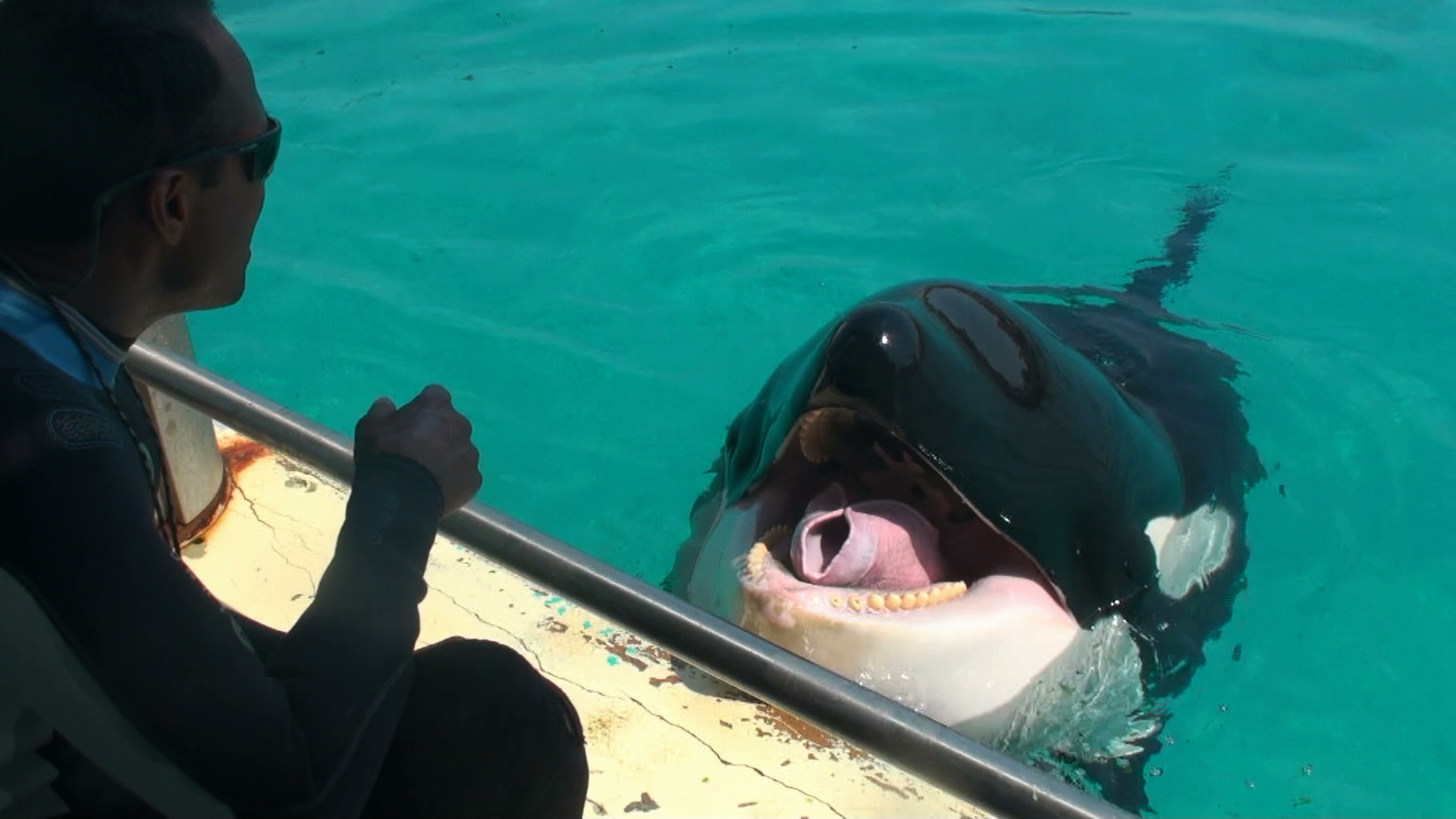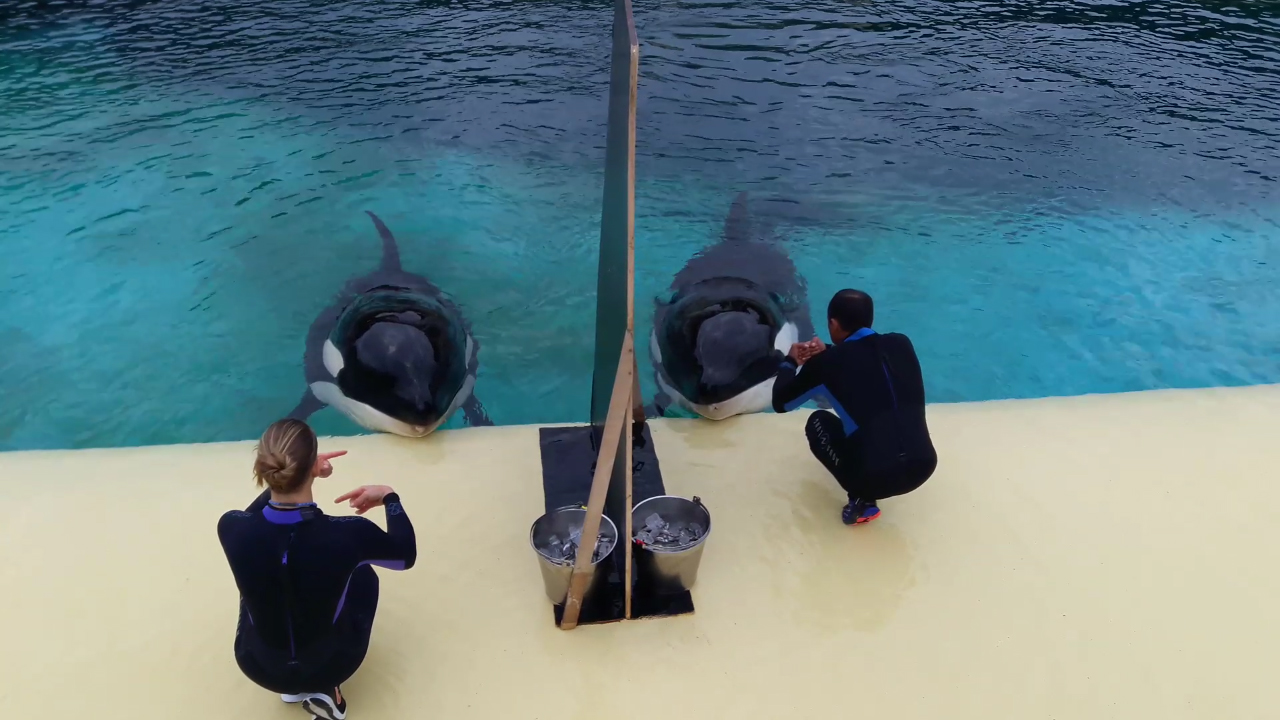Killer Impression: Orca Mimics 'Hello' and 'Bye-Bye'
Researchers recently found that a female killer whale could copy the phrases "hello," "bye-bye," "Amy," and "one, two, three." The orca could also imitate a wolf's howl, an elephant's trumpeting, and the sounds of a creaking door and a "raspberry." And she reproduced the new sounds quickly, some within the first attempt.
Orcas are known to communicate amongst themselves using an array of sounds, and the animals have even demonstrated "dialects" — variations in communication signals that are specific to certain groups of the animals — the scientists reported in a new study. The findings suggest that a captive whale's ability to deftly mimic unfamiliar noises hints that imitation likely plays an important role in building orcas' unique "vocal traditions." [Image Gallery: Russia's Beautiful Killer Whales]
"The intricacy of killer whale communication reflects their complex social structure and mental comprehension," Rachael Griffin, a biologist with Aquagreen Marine Research in Victoria, British Columbia, told Live Science in an email. Griffin was not involved in the recent study.
Whale spoken
It is unknown how wild orcas develop their unique dialects, and the study authors wanted to test the mimicry abilities of a captive orca, to see if that might be a factor.
To do so, the researchers worked with a 14-year-old captive orca named Wikie at the Marineland aquarium in Antibes, France. In 30 trials, the scientists presented Wikie with recordings of unfamiliar sounds and words spoken by trainers, which the whale was then instructed to copy as in-air vocalizations (rather than underwater). Previous sessions with Wikie had already trained her to respond to a "do this" command for a fish reward, the study authors reported.
Then, the scientists compared her calls with the original sounds using dynamic time warping (DTW), an algorithm that maps two linear sequences, calculating where they match. The researchers also had blindfolded judges listen to audio samples — original and orca-produced — and decide whether the recordings sounded similar.

The researchers found that Wikie successfully copied all of the sounds, most of them in fewer than 10 tries. She successfully reproduced some sounds — such as the phrases "hello" and "one, two, three" — on her first attempt. They weren't perfect imitations, but they were certainly recognizable, the study authors reported.
Sign up for the Live Science daily newsletter now
Get the world’s most fascinating discoveries delivered straight to your inbox.
The rate of successful "pronunciation" varied; Wikie produced an accurate version of "hello" 55 percent of the time, while her "bye-bye" was correct only 21 percent of the time, according to the study.
Interestingly, DTW analysis showed that in some cases, Wikie's mimicry of unfamiliar sounds was better than her mimicry of familiar ones, the scientists noted.
Talk, talk
Orcas are not the only masters of mimicry in the animal kingdom. The polka-dot wasp moth mimics the warning thrum produced by a bad-tasting moth species, to protect itself from predators, scientists reported in May 2007, in the journal Proceedings of the National Academy of Sciences. A type of cat called a margay, native to the Amazon, mimics the calls of pied tamarins, to lure the unsuspecting monkey prey, while a bird known as the fork-tailed drongo can imitate the alarm calls of as many as 45 other bird species, according to a study published in May 2014 in the journal Science.
Another standout copycat, the lyrebird, mimics not only other animals, but also the sounds of construction equipment and car horns, demonstrating its prowess in the 2009 documentary series "BBC Earth."

Some types of birds, such as parrots, parakeets and cockatoos, are particularly adept at copying human speech. In fact, an African grey parrot recently garnered headlines by mimicking human speech so accurately that the bird was referenced in a murder trial, allegedly for speaking what may have been its owner's last words before the man was killed.
And in 2006, scientists reported in the journal Biology Letters that a killer whale in Nootka Sound, British Columbia, could imitate a sea lion's bark — likely because the orca was solitary "and striving for attention," said Griffin, one of the researchers who analyzed those calls.
Sound without meaning
Recent studies have offered additional examples of "talking" animals: a beluga whale in San Diego's National Marine Mammal Foundation that could say the word "out," and a zoo elephant in South Korea named Koshik that can say, "hello," "good," "no," "sit down" and "lie down" in Korean.
Animals that live with people or who are habituated to them through captivity may copy elements of human speech in order to strengthen social bonds, Angela Stoeger-Horwath, a bioacoustician at the University of Vienna and co-author of the elephant study, previously told Live Science.
But just because animals can mimic human sounds, that does not mean that they understand our language, she added.
"Koshik mainly seems to be using these vocalizations as a way of bonding with people, rather than for their meaning," Stoeger-Horwath said.
The new study's findings suggest that killer whales can learn and imitate new sounds by listening to them. However, because the experiments were conducted above water, the results don't indicate how accurately wild orcas may reproduce unfamiliar sounds that they hear underwater, and further investigation will be required to gauge the role that mimicry plays in orcas' social communication, the scientists wrote in the study.
The findings were published online today (Jan. 30) in the journal Proceedings of the Royal Society B: Biological Sciences.
Original article on Live Science.

Mindy Weisberger is an editor at Scholastic and a former Live Science channel editor and senior writer. She has reported on general science, covering climate change, paleontology, biology and space. Mindy studied film at Columbia University; prior to Live Science she produced, wrote and directed media for the American Museum of Natural History in New York City. Her videos about dinosaurs, astrophysics, biodiversity and evolution appear in museums and science centers worldwide, earning awards such as the CINE Golden Eagle and the Communicator Award of Excellence. Her writing has also appeared in Scientific American, The Washington Post and How It Works Magazine. Her book "Rise of the Zombie Bugs: The Surprising Science of Parasitic Mind Control" will be published in spring 2025 by Johns Hopkins University Press.









